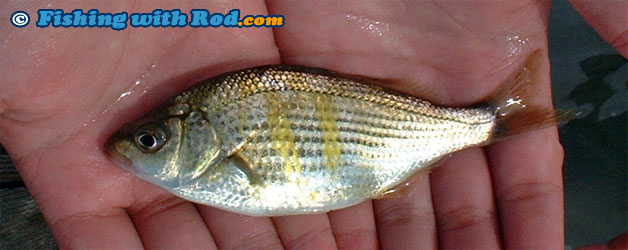Shiner Perch
Cymatogaster aggregata

You find them by the hundreds around rocks, jetties and kelp beds. Shiner perch is the smaller species in the surf perch family. They are especially popular among young anglers since they are abundant and easy to catch.
Description
Shiner perch are silver in colour, with up to eight longitudinal dark stripes from head to tail. These stripes are often intercepted by three broad yellow bands. Their body is deep, compressed and protected with relatively large scales. Fins are usually colourless. Three spines are located at the anal fin. The caudal fin (tail) tends to have a fleshy colour at times. Maximum body length is around 20cm.
Distribution
Shiner perch are mainly found along the coastal waters of Eastern Pacific from Southern Alaska to Northern California.
Life History
Shiner perch are mainly found in shallow coastal waters that are heavily vegetated or structured. Schools of shiner perch often inhabit within eelgrass or kelp beds, near pilings, piers or other submerged artificial structures. They also have a tendency to move into estuaries, brackish or fresh waters. Seasonal movement from one area to another occurs. Youngs mainly feed on copepods, while adults feed on larger preys such as mollusks, crustaceans and algae.
Fishing Locations
Shiner perch can be caught almost anywhere along the shoreline during summer months. Look for small jetties, rocky shoreline, and heavily weeded area. Schools can often be spotted if they are present on a sunny day. In late summer, shiner perch are plentiful in the estuary Fraser River. They are very abundant in Burrard Inlet, Howe Sound, Gulf Islands, anywhere along the East and West Coast of Vancouver Island.
Fishing Techniques
A complex setup is not needed for shiner perch, therefore they are popular among kids in the summer. A small rod and reel setup, fitted with 2lb line and a size 12 hook at the end is sufficient enough for shiner perch as they are not very big. Look for surface activities. Add a couple of split shots above the hook if fish are found in deeper waters. Bait that can be effective include shrimps, small pieces of fish flesh, small crabs, squid and dough. Use small enough bait so the tip of the hook is exposed. If you are having problems detecting bites, attach a small float several feet above the hook.
